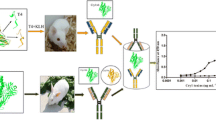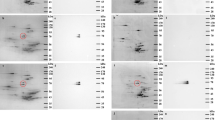Abstract
Recombinant allergens and antibodies are needed for diagnostic, therapeutic, food processing and quality verification purposes. The aim of this work was to develop a barley-based production system for β-lactoglobulin (BLG) specific immunoglobulin E antibody (D1 scFv). The expression level in the best barley cell clone was 0.8–1.2 mg/kg fresh weight, and was constant over an expression period of 21 days. In the case of barley grains, the highest stable productivity (followed up to T2 grains) was obtained when the D1 scFv cDNA was expressed under a seed-specific Glutelin promoter rather than under the constitutive Ubiquitin promoter. Translational fusion of ER retention signal significantly improved the accumulation of recombinant antibody. Furthermore, lines without ER retention signal lost D1 scFv accumulation in T2 grains. Pilot scale purification was performed for a T2 grain pool (51 g) containing 55.0 mg D1 scFv/kg grains. The crude extract was purified by a two-step purification protocol including IMAC and size exclusion chromatography. The purification resulted in a yield of 0.47 mg of D1 scFv (31 kD) with high purity. Enzyme-linked immunosorbent assay revealed that 29 % of the purified protein was fully functional. In immunoprecipitation assay the purified D1 scFv recognized the native 18 kD BLG in the milk sample. No binding was observed with the heat-treated milk sample, as expected. The developed barley-based expression system clearly demonstrated its potential for application in the processing of dairy milk products as well as in detecting allergens from foods possibly contaminated by bovine milk.





Similar content being viewed by others
References
Akdis CA, Blaser K (2000) Mechanisms of allergen-specific immunotherapy. Allergy 55:522–530
Azzoni AR, Kusnadi AR, Miranda EA, Nikolov ZL (2002) Recombinant aprotinin produced in transgenic corn seed: extraction and purification studies. Biotech Bioeng 80:268–276
Bartlett JG, Alves SC, Smedley M, Snape JW, Harwood WA (2008) High-throughput Agrobacterium-mediated barley transformation. Plant Methods 4:22. doi:10.1186/1746-4811-4-22
Boothe J, Nykiforuk C, Shen Y, Zaplachinski S, Szarka S, Kuhlman P, Murray E, Morck D, Moloney MM (2010) Seed-based expression systems for plant molecular farming. Plant Biotech J 8:588–606
Bradford MM (1976) A rapid and sensitive method for quantitation of microgram quantities of protein utilizing the principle of protein dye binding. Anal Biochem 72:248–254
Christensen AH, Quail PH (1996) Ubiquitin promoter-based vectors for high-level expression of selectable and/or screenable marker genes in monocotyledonous plants. Transgenic Res 5:213–218
Eskelin K, Ritala A, Suntio T, Blumer S, Holkeri H, Wahlström EH, Baez J, Mäkinen K, Nuutila AM (2009) Production of a recombinant full-length collagen type I α-1 and of a 45-kDa collagen type I α-1 fragment in barley seeds. Plant Biotech J 7:657–672
Fischer R, Emans N (2000) Molecular farming of pharmaceutical proteins. Transgenic Res 9:279–299
Haseloff J, Siemering KR, Prasher DC, Hodge S (1997) Removal of a cryptic intron and subcellular localization of green fluorescent protein are required to mark transgenic Arabidopsis plants brightly. Proc Natl Acad Sci USA 94:2122–2127
Hensel G, Valkov V, Middlefell-Williams J, Kumlehn J (2007) Efficient generation of transgenic barley: the way forward to modulate plant–microbe interactions. J Plant Physiol 165:71–82
Høst A (2002) Frequency of cow’s milk allergy in childhood. Ann Allergy Asthma Immunol 89:33–37
Jabed A, Wagner S, McCracken J, Wells DN, Laible G (2012) Targeted microRNA expression in dairy cattle directs production of β-lactoglobulin-free, high-casein milk. Proc Natl Acad Sci USA 109:16811–16816
Jylhä S, Mäkinen-Kiljunen S, Haahtela T, Söderlund H, Takkinen K, Laukkanen M-L (2009) Selection of recombinant IgE antibodies binding the β-lactoglobulin allergen in a conformation-dependent manner. J Immunol Meth 350:63–70
Kim JS, Nowak-Wegrzyn A, Sicherer SH, Noone S, Moshier EL, Sampson HA (2011) Dietary baked milk accelerates the resolution of cow’s milk allergy in children. J Allergy Clin Immunol 128:125–131
Lazo GR, Stein PA, Ludwig RA (1991) A DNA transformation-competent Arabidopsis genomic library in Agrobacterium. Bio/Tech 9:963–967
Ma JK, Drake PM, Christou P (2003) The production of recombinant pharmaceutical proteins in plants. Nat Rev Genet 4:794–805
Majamaa H, Isolauri E (1997) Probiotics: a novel approach in the management of food allergy. J Allergy Clin Immunol 99:179–185
Murray MG, Thompson WF (1980) Rapid isolation of high molecular weight plant DNA. Nucl Acids Res 8:4321–4325
Negrouk V, Eisner G, Lee H, Han K, Taylor D, Wong HC (2005) Highly efficient transient expression of functional recombinant antibodies in lettuce. Plant Sci 169:433–438
Niemi M, Jylhä S, Laukkanen M-L, Söderlund H, Mäkinen-Kiljunen S, Kallio JM, Hakulinen N, Haahtela T, Takkinen K, Rouvinen J (2007) Molecular interactions between a recombinant IgE antibody and β-lactoglobulin allergen. Structure 15:1413–1421
Nowak-Wegrzyn A, Bloom KA, Sicherer SH, Shreffler WG, Noone S, Wanich N, Sampson HA (2008) Tolerance to extensively heated milk in children with cow’s milk allergy. J Allergy Clin Immunol 122:342–347
Ritala A, Wahlström EH, Holkeri H, Hafren A, Mäkeläinen K, Baez J, Mäkinen K, Nuutila AM (2008) Production of recombinant industrial protein using barley cell cultures. Protein Expr Purif 59:274–281
Schillberg S, Fischer R, Emans N (2003) Molecular farming of recombinant antibodies in plants. Cell Mol Life Sci 60:433–445
Shreffler WG, Wanich N, Moloney M, Nowak-Wegrzyn A, Sampson HA (2009) Association of allergen-specific regulatory T cells with the onset of clinical tolerance to milk protein. J Allergy Clin Immunol 123:43–52
Stöger E, Sack M, Fischer R, Christou P (2002) Plantibodies: applications, advantages and bottlenecks. Curr Opin Biotech 13:161–166
Vaquero C, Sack M, Chandler J, Drossard J, Scuuster F, Monecke M, Schillberg S, Fischer R (1999) Transient expression of a tumor-specific single chain fragment and a chimeric antibody in tobacco leaves. Proc Natl Acad Sci USA 96:11128–11133
Virkud YV, Vickery BP (2012) Advances in immunotherapy for food allergy. Discov Med 14:159–165
Vitale A, Hinz G (2005) Sorting of proteins to storage vacuoles: How many mechanisms? Trends Plant Sci 10:316–323
Wang MB, Upadhyaya MN, Brettell RIS, Waterhouse PM (1997) Intron mediated improvement of a selectable marker gene for plant transformation using Agrobacterium tumefaciens. J Genet Breed 51:325–334
Wang MB, Matthews PR, Upadhyaya MN, Waterhouse PM (1998) Improved vectors fro Agrobacterium tumefaciens-mediated plant transformation. Acta Hort 461:401–407
Wanich N, Nowak-Wegrzyn A, Sampson HA, Shreffler WG (2009) Allergen-specific basophil suppression associated with clinical tolerance in patients with milk allergy. J Allergy Clin Immunol 123:789–794
Acknowledgments
We thank Kristiina Takkinen for fruitful discussions, Armi Boman, Sirkka-Liisa Kanervo, Annika Majanen, Anja Pallas, Jaana Rikkinen and Tuuli Teikari for excellent technical assistance and Michael Bailey for language revision. This work was supported by the Academy of Finland (decision 121595) and Indian Department of Biotechnology (No. BT/IN/Finnish/15/VSR/2007) and EU-COST FA0804 Action ‘Molecular farming: plants as a production platform for high value proteins‘. The authors declare no conflicts of interests.
Author information
Authors and Affiliations
Corresponding author
Electronic supplementary material
Below is the link to the electronic supplementary material.
Rights and permissions
About this article
Cite this article
Ritala, A., Leelavathi, S., Oksman-Caldentey, KM. et al. Recombinant barley-produced antibody for detection and immunoprecipitation of the major bovine milk allergen, β-lactoglobulin. Transgenic Res 23, 477–487 (2014). https://doi.org/10.1007/s11248-014-9783-2
Received:
Accepted:
Published:
Issue Date:
DOI: https://doi.org/10.1007/s11248-014-9783-2




